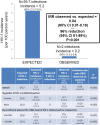Integrated Delivery of Antiretroviral Treatment and Pre-exposure Prophylaxis to HIV-1-Serodiscordant Couples: A Prospective Implementation Study in Kenya and Uganda
- PMID: 27552090
- PMCID: PMC4995047
- DOI: 10.1371/journal.pmed.1002099
Integrated Delivery of Antiretroviral Treatment and Pre-exposure Prophylaxis to HIV-1-Serodiscordant Couples: A Prospective Implementation Study in Kenya and Uganda
Abstract
Background: Antiretroviral-based interventions for HIV-1 prevention, including antiretroviral therapy (ART) to reduce the infectiousness of HIV-1 infected persons and pre-exposure prophylaxis (PrEP) to reduce the susceptibility of HIV-1 uninfected persons, showed high efficacy for HIV-1 protection in randomized clinical trials. We conducted a prospective implementation study to understand the feasibility and effectiveness of these interventions in delivery settings.
Methods and findings: Between November 5, 2012, and January 5, 2015, we enrolled and followed 1,013 heterosexual HIV-1-serodiscordant couples in Kenya and Uganda in a prospective implementation study. ART and PrEP were offered through a pragmatic strategy, with ART promoted for all couples and PrEP offered until 6 mo after ART initiation by the HIV-1 infected partner, permitting time to achieve virologic suppression. One thousand thirteen couples were enrolled, 78% of partnerships initiated ART, and 97% used PrEP, during a median follow-up of 0.9 years. Objective measures of adherence to both prevention strategies demonstrated high use (≥85%). Given the low HIV-1 incidence observed in the study, an additional analysis was added to compare observed incidence to incidence estimated under a simulated counterfactual model constructed using data from a prior prospective study of HIV-1-serodiscordant couples. Counterfactual simulations predicted 39.7 HIV-1 infections would be expected in the population at an incidence of 5.2 per 100 person-years (95% CI 3.7-6.9). However, only two incident HIV-1 infections were observed, at an incidence of 0.2 per 100 person-years (95% CI 0.0-0.9, p < 0.0001 versus predicted). The use of a non-concurrent comparison of HIV-1 incidence is a potential limitation of this approach; however, it would not have been ethical to enroll a contemporaneous population not provided access to ART and PrEP.
Conclusions: Integrated delivery of time-limited PrEP until sustained ART use in African HIV-1-serodiscordant couples was feasible, demonstrated high uptake and adherence, and resulted in near elimination of HIV-1 transmission, with an observed HIV incidence of <0.5% per year compared to an expected incidence of >5% per year.
Conflict of interest statement
All authors have read the journal's policy and have the following competing interests: Gilead Sciences donated the PrEP medication used in this study. CH received prior funding (05/01/09-04/30/10) for a pharmacokinetics study of TDF in the colon and female genital tract from Gilead Sciences and has a patent pending using a different formulation of the drug used in this study.
Figures



Comment in
-
HIV treatment and anal cancer: emerging clarity.Lancet HIV. 2020 Apr;7(4):e220-e221. doi: 10.1016/S2352-3018(20)30027-8. Epub 2020 Feb 25. Lancet HIV. 2020. PMID: 32109409 No abstract available.
References
Publication types
MeSH terms
Substances
Grants and funding
LinkOut - more resources
Full Text Sources
Other Literature Sources
Medical
Miscellaneous

